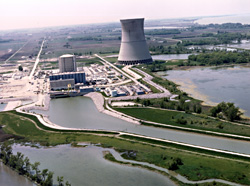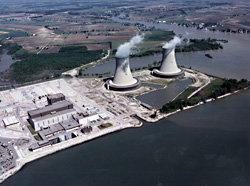Anti-Davis-Besse coalition defends cracked shield building contentions against challenges from FirstEnergy and NRC staff
 In mid-October 2011, revelations about severe cracking in the Davis-Besse shield building on the Lake Erie shore were first made publicToday the environmental coalition opposing the 20 year extension at the problem-plagued Davis-Besse atomic reactor near Toledo defended its contention about the recently revealed severe cracking in the concrete shield building against challenges by FirstEnergy nuclear utility, as well as the U.S. Nuclear Regulatory Commission staff. Terry Lodge of Toledo serves as the coalition's attorney.
In mid-October 2011, revelations about severe cracking in the Davis-Besse shield building on the Lake Erie shore were first made publicToday the environmental coalition opposing the 20 year extension at the problem-plagued Davis-Besse atomic reactor near Toledo defended its contention about the recently revealed severe cracking in the concrete shield building against challenges by FirstEnergy nuclear utility, as well as the U.S. Nuclear Regulatory Commission staff. Terry Lodge of Toledo serves as the coalition's attorney.
One revelation the coalition exposed today is that FirstEnergy, with NRC staff complicity, kept secret from the public, and even from FirstEnergy investors, cracking in the upper 20 feet of the structure for five weeks -- until pressure by U.S. Congressman Dennis Kucinich (Democrat-Ohio) forced NRC staff to admit the truth to his staff. Kucinich made the information public the very next day, and won NRC Chairman Gregory Jackzo's support for an NRC public meeting near Davis-Besse, where FirstEnergy was forced to admit publicly for the first time the expanded extent of the problem.
The environmental coalition intervening against Davis-Besse's license extension includes Beyond Nuclear, Citizens Environment Alliance of Southwestern Ontario, Don't Waste Michigan, and the Green Party of Ohio. Davis-Besse has had a disproportionately large number of near-misses with disaster in its 35 years of operations, including a Three Mile Island precursor incident 18 months before the infamous meltdown, a very dicey direct hit by a tornado in 1998, and its own infamous "Hole-In-The-Head Fiasco" in 2002.
 admin
admin






